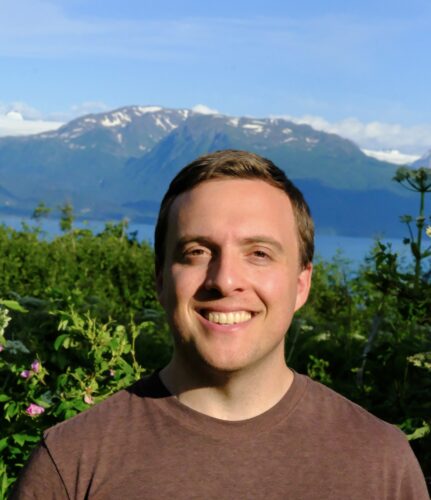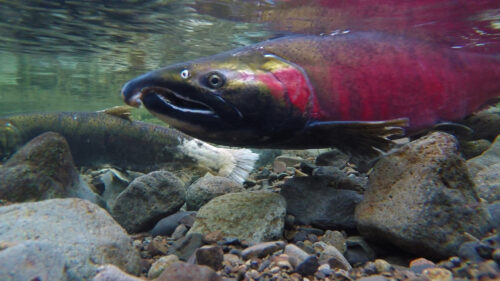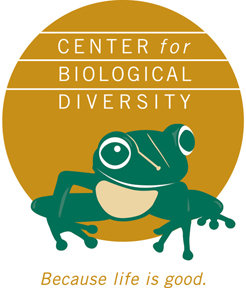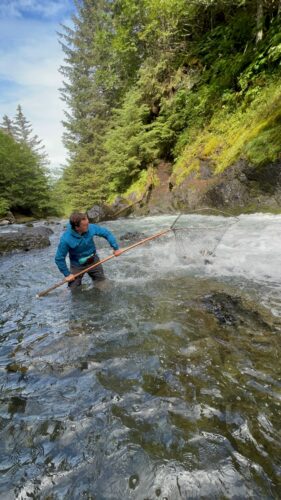
He Fights For Alaska’s Fish And Wildlife Futures
The following appears in the June issue of Alaska Sporting Journal:


BY TIFFANY HERRINGTON
Alaska is one of the last places on Earth where nature still dominates. It’s a land of salmon-packed rivers, towering glaciers and caribou migrations that have played out for thousands of years.
But the Last Frontier is also a battleground. Industrial fishing fleets, mining projects and fossil fuel expansion are pushing deeper into its wild spaces, threatening the ecosystems and communities that depend on them.
Cooper Freeman has made it his life’s work to fight back. As Alaska director for the Center for Biological Diversity, he moves between courtrooms, remote villages and government offices, challenging policies that put short-term profit over long-term sustainability. His work spans everything from stopping destructive mining projects to protecting marine life from industrial trawling.
In this interview, Freeman discusses the biggest conservation battles facing Alaska today, the political challenges that shape the fight, and what keeps him motivated. It’s a look at what’s at stake – and what can still be saved. Alaska’s wild places face immense challenges, but advocates like Cooper Freeman and the Center for Biological Diversity are fighting every day to protect them.

Tiffany Herrington What first drew you to conservation work, and how did you end up at the Center for Biological Diversity?
Cooper Freeman I grew up outside – running rivers, skiing, hiking – but everything shifted when I spent nearly a decade as a Class V whitewater river guide. I was surrounded by incredible landscapes, but I also saw firsthand how threatened they were – dams, severe water pollution.
One moment that stuck with me was the Mount Polley Mine tailings dam breach in British Columbia. It released around 20 million cubic meters of waste into the Fraser River. We’d finish river trips at a large fish camp on the riverbanks. After the spill, when we pulled out our boats, they were coated in thick orange sludge. The fish racks were empty, the smokehouses silent. It wasn’t just a fish run lost; it was a way of life gone.
I saw similar things globally. In Africa, habitat destruction threatened lions, elephants and hippos. In Patagonia, deforestation impacted old-growth forests and pumas. In the Himalayas, pollution and development were wiping out birds, fish and wildflowers.
Eventually, I couldn’t just be a spectator. Alaska – with its vast, intact ecosystems – felt like the right place to commit my work. That led me to the Center for Biological Diversity, where we use science, the law and creative media to protect life on Earth.
I consider myself an all-purpose activist. I have a background in law and some experience in science, and I use whatever tools are necessary to protect biodiversity, habitats and the climate they depend on. Some of my time is spent on legal work, some on digging into the science, and a lot of it is connecting with people on the ground – communities threatened by destructive projects and tribes fighting to protect their traditional homelands and subsistence resources.

TH What does protecting Alaska’s public lands and wildlife mean to you personally?
CF Alaska is unlike anywhere else. Its scale and intact ecosystems are what make it remarkable. We still have rivers full of wild salmon, ancient forests where bears roam and caribou migrations that haven’t changed for thousands of years. That’s rare, and it’s worth fighting for. Protecting these ecosystems isn’t just about scenery; it’s survival. They filter our air and water, regulate the climate and sustain biodiversity.
Bristol Bay is home to the world’s largest sockeye salmon run. The Brooks Range supports the world’s longest terrestrial migration – Western Arctic caribou moving through truly wild lands. But projects like the Pebble Mine threaten Bristol Bay’s waters and salmon. The Ambler Road would cut through caribou migration routes, crossing nearly 3,000 freshwater streams. These projects don’t just impact one species; they disrupt entire ecosystems and threaten Alaska’s identity.
We spend a lot of time working with small-boat, family-owned fishing operations – people who want to pass their boats and permits down to the next generation and keep the watersheds they rely on intact. Alaska’s tight-knit communities remind us what we’re fighting for: the birds, the insects, the flowers, the animals, the fish. That’s what makes life worth living.
TH How do you navigate advocacy work when administrations shift policies on mining and drilling?
CF The fight never stops. Every administration brings new challenges. We’ve seen conservation wins under the Biden Administration, but also major setbacks. The Willow Project is the largest Arctic oil drilling project in decades. The administration also advanced the road through Izembek National Wildlife Refuge, threatening vital bird habitat.
Even when we win – like halting Ambler Road – the fight isn’t over. Permits can return. Policies flip. We must be relentless. The last administration prioritized profits over sustainability. But no matter who’s in office, our mission stays the same: Keep oil in the ground, stop destructive mining and protect ecosystems future generations depend on. Switching between D.C. politics and conversations in small Alaskan communities isn’t easy, but it’s essential. Our work is about bridging that gap between courts, government agencies and the people directly affected.

TH Some argue that conservation hurts Alaska’s economy. What is your take on that?
CF It depends on the economy you want. If it’s a short-term boom and bust – profits flowing out of state while communities are left behind – then unchecked extraction fits. But if you want an economy that supports Alaskans for generations, environmental protections are essential. Industries like fishing, tourism and outdoor recreation provide sustainable jobs without sacrificing our resources.
Bristol Bay’s salmon fishery generates $2 billion annually and supports 15,000 jobs. That’s a renewable economy. If the Pebble Mine contaminates those waters, that economy is gone – forever. The real question is: Do we build an economy that destroys natural resources or one that preserves them?
And it’s not just our lands; we’re seeing the same thing happen with Alaska’s waters. Our public waters and oceans are being commodified. Corporate trawlers, based in Alaska but owned by massive companies, are plundering the Bering Sea and Gulf of Alaska. These industrial operations have devastating effects on marine ecosystems and kill countless nontarget species through bycatch. Alaskans are pushing back, fighting for a sustainable vision that prioritizes small-boat, family-owned fisheries supporting local communities.
TH Predator hunting is controversial in Alaska. What’s your take on recent rollbacks of hunting regulations on public lands?
CF We’re not anti-hunting or anti-fishing. What we oppose is unethical hunting that violates fair chase principles and disrupts ecosystems. Chasing wolves with snowmachines, killing wolf pups in dens, baiting bears – these aren’t management tools. They’re political moves to eliminate predators, and they don’t belong on public lands.

TH Some say predator control is needed for healthy game populations. How would you respond to that?
CF The key is science. Predator control hasn’t been proven to help ungulate populations long-term. In many cases, it harms them by disrupting predator-prey balance. Wildlife management should maintain ecological balance; not boost one species for another’s sake. Climate change, habitat loss and disease threaten caribou and moose far more than predators. That’s where the focus should be.
TH What role do wolves and bears play in ecosystem health?
CF Predators are critical. Wolves strengthen caribou herds by culling the weak. Brown bears fertilize forests by dragging salmon inland, spreading marine nutrients. When we reduce predator numbers, we weaken ecosystems and even lose tourism revenue. People come from around the world to see wolves in Denali, bears in Katmai, caribou herds in the Arctic. Predators are ecologically and economically vital.

TH What are the biggest conservation battles ahead? What’s not getting enough attention?
CF The Johnson Tract gold mine is a major threat. It’s within Lake Clark National Park and the Alaska Maritime National Wildlife Refuge. The mine and its port could devastate Lake Clark’s brown bears, pollute Cook Inlet’s last razor clam beds, disrupt seabird nesting sites and destroy the only known winter feeding grounds for endangered Cook Inlet belugas.
Local lodges, tribes, fishermen, birders, beluga advocates – all are united against it. This is a gold mine – no national security or renewable energy benefit – and just another short-term project leaving behind a toxic waste dump in one of Alaska’s most remarkable places. Stopping it is a top priority.
TH Climate change is hitting Alaska hard. How is the Center addressing the impacts?
CF Alaska’s on the front lines. Rising temperatures, melting permafrost, shifting wildlife – everything’s changing fast. Ice-dependent species like seals, polar bears and whales are in trouble as their world disappears. Caribou and musk oxen face starvation when winter rain freezes tundra forage. Salmon runs are collapsing on rivers like the Yukon and Kuskokwim. We must stop new fossil fuel projects and phase out existing ones. Alaska’s future – ecological and economic – depends on it.
TH What key projects are you working on to protect watersheds and marine ecosystems?
CF One of our main priorities is fighting the corporate trawling industry and blocking new offshore oil and gas in the Arctic and Bering Sea. Industrial trawlers are stripping the base of the food chain – taking fish vital to whales, sea lions and marine mammals. Bycatch kills countless nontarget species. It’s one of the most destructive industries operating in Alaska. We’re working creatively with others to push back, because once these ecosystems are gone, they don’t come back. Alaska’s waters should remain a resource for Alaskans and future generations; not corporate profit.
TH How can everyday Alaskans get involved?
CF Take the long view. Mines may operate for a decade, but the damage lasts forever. Push for sustainable, local economies. Urge elected officials to stop selling Alaska’s lands and waters to outside corporations. Invest in what sustains Alaska for generations.
TH What keeps you motivated? What gives you hope for Alaska’s wild places?
CF There’s still so much left worth fighting for. You can still see massive brown bears, hear birds in the morning and spend weeks in true wilderness. That’s rare and precious. Every time I’m out on the bay, watching whales and seabirds, I’m reminded of what’s at stake. That’s what keeps me inspired – and why I keep fighting every day. ASJ
Editor’s note: To learn more about the Center for Biological Diversity’s work, visit biologicaldiversity.org.



